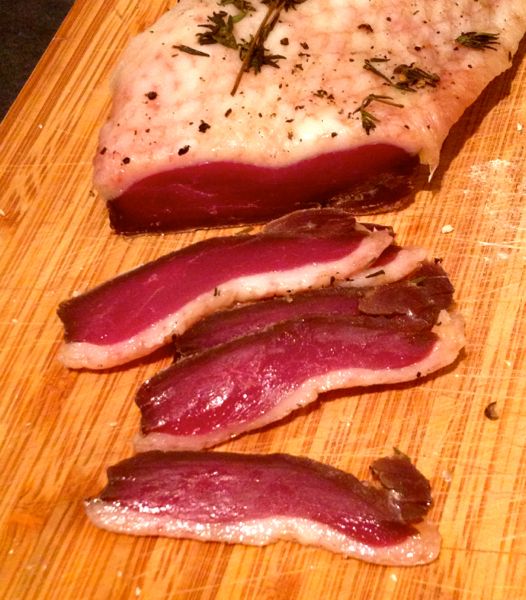Duck Ham or Prosciutto
A few years ago, I discovered how easy it was to make your own bacon and Mister North and our mum followed suit, making their own guanciale and bacon on several occasions. It’s certainly given carbonara and an Ulster Fry a new lease of life in our family.
I’d wondered for a while if you could cure pig’s jowls or belly, what else could get the sugar-salt-saltpetre treatment and decided to try making duck bacon for Christmas. I got massively distracted and the duck breasts I bought for the purpose got left in the freezer until a few weeks ago. I wanted something simple but effective to make while working on other stuff and this seemed just the ticket.
On a semantic note, I found it hard to tell what the difference between duck ham and duck bacon was when researching the idea. Tim Hayward in Food DIY uses a cure close to my bacon recipe but calls it ham and most recipes from American food bloggers seemed to call it bacon when it had been smoked rather than simply cured and air dried. Lots of other people described it as duck prosciutto. I’m still not sure what to call it apart from very easy and incredibly delicious.
Duck Ham/Prosciutto/Bacon
- 2 duck breasts
- 200g sea salt
- 200g sugar
- 3 tablespoons fresh thyme, chopped
- 1 tablespoon juniper berries, crushed
- 1 tablespoon maple syrup or treacle
- 1 tablespoon lapsang souchoung tea leaves
- 1 teaspoon coarse ground black pepper
- 1/4 teaspoon saltpetre (optional)
This is ridiculously easy and works just as well without the saltpetre as with, but had a slightly richer more ruby colour to the meat when I used it. The lapsang souchoung tea leaves add a smoky note that works beautifully without having to start rigging up a smoker or adding the heat of any kind of chilli.
Lay the duck breasts skin side up in a non reactive container. I used one of my many many tupperware boxes after having had ziplock bag disasters before.
Mix the salt, sugar, herbs, pepper and tea leaves (and saltpetre) together and add the maple syrup or treacle to it all to make a thick barely spreadable paste. Smear some onto the skin of the duck breasts and then turn over and cover the meat well.
Put the lid on the box and leave it all to cure in the fridge for 3 to 5 days. The cure will create a brine and it’s best to turn the breasts everyday in this to cure it evenly. I forgot about mine after 3 days and left it for another 2, ignoring it somewhat.
When you remember about it again, take the breasts out of the cure and wrap in a clean muslin cloth. Hang this little muslin parcel up somewhere not too warm and away from pets to air dry. I use the clothes airer in my bedroom but it would be fine in a garage or cold hallway as well.
After 5 days, unwrap your duck breasts and slice as thinly as possible to serve. It will have a subtle smoky and herby flavour that goes very well with a kale salad and roasted tomatoes for lunch or topped with sauerkraut, pickles and cheese in a Reuben inspired sandwich along with a quick Thousand Island style dressing with mayonnaise, ketchup, onion, gherkin and a little green chilli all blitzed up together. This was so delicious I forgot to take any kind of photograph of it. I think I barely used a plate I was so keen to eat it.
This is a great way to make a duck breast go a long way and serve several people making it both economical and incredibly impressive looking as a dish. Your use of it is only limited by your imagination!




















